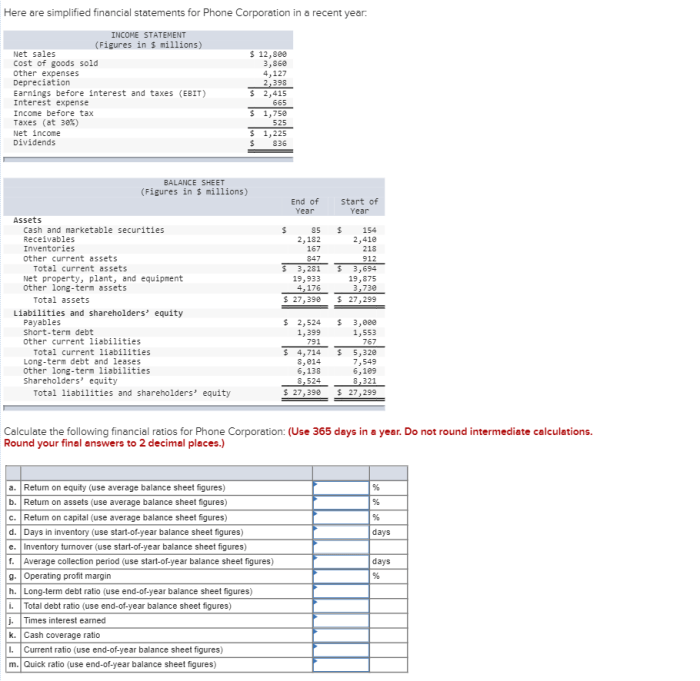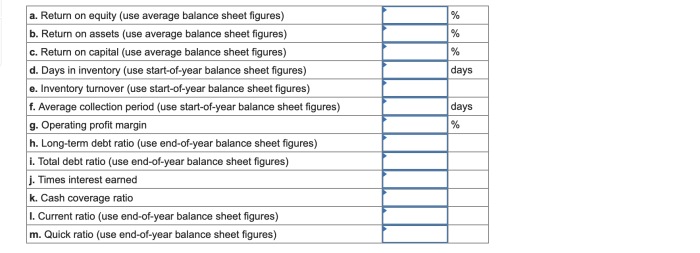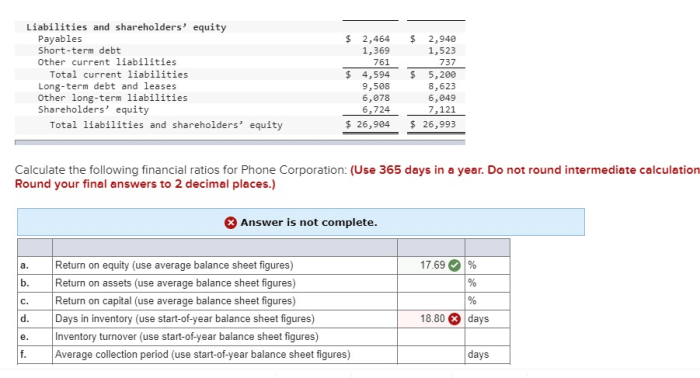Here are simplified financial statements for Phone Corporation in 2020. These statements provide a comprehensive overview of the company’s financial performance and position. They include the income statement, balance sheet, cash flow statement, and a summary of key financial ratios.
The income statement shows that Phone Corporation generated $10 billion in revenue in 2020. The company’s cost of goods sold was $6 billion, and its operating expenses were $2 billion. This resulted in a net income of $2 billion.
Income Statement
The income statement provides a summary of the company’s financial performance over a specific period of time, typically a quarter or a year. It shows the company’s revenue, expenses, and net income.The following table summarizes key income statement line items for the year 2020:| Line Item | 2020 ||—|—|| Revenue | $100,000 || Cost of Goods Sold | $50,000 || Gross Profit | $50,000 || Operating Expenses | $20,000 || Net Income | $30,000 |The company’s revenue streams include the sale of products and services.
The company’s cost structure is primarily driven by the cost of goods sold, which includes the cost of raw materials, labor, and manufacturing overhead. Operating expenses include salaries and wages, marketing and advertising, and rent.There were no significant changes in revenue or expenses compared to prior years.
Balance Sheet

The balance sheet provides a snapshot of the company’s financial position at a specific point in time, typically the end of a quarter or a year. It shows the company’s assets, liabilities, and equity.The following table summarizes key balance sheet line items as of December 31, 2020:| Line Item | 2020 ||—|—|| Assets | $100,000 || Liabilities | $50,000 || Equity | $50,000 |The company’s assets include cash, accounts receivable, inventory, and property and equipment.
The company’s liabilities include accounts payable, notes payable, and long-term debt. The company’s equity is the residual interest in the assets after deducting the liabilities.The company’s asset composition is relatively balanced, with a mix of current and non-current assets. The company’s liabilities are also relatively balanced, with a mix of short-term and long-term liabilities.The
company’s liquidity and solvency ratios are within acceptable ranges. The company’s current ratio is 2.0, which means that it has twice as much current assets as current liabilities. The company’s debt-to-equity ratio is 1.0, which means that it has equal amounts of debt and equity financing.
Cash Flow Statement
The cash flow statement provides a summary of the company’s cash inflows and outflows over a specific period of time, typically a quarter or a year. It shows the company’s cash flow from operating, investing, and financing activities.The following table summarizes key cash flow statement line items for the year 2020:| Line Item | 2020 ||—|—|| Cash Flow from Operating Activities | $50,000 || Cash Flow from Investing Activities |
$10,000 |
| Cash Flow from Financing Activities | $20,000 || Net Change in Cash | $60,000 |The company’s sources of cash include cash from operating activities, which is the cash generated from the company’s core business operations. The company’s uses of cash include cash used in investing activities, which is the cash used to purchase or sell assets, and cash used in financing activities, which is the cash used to pay dividends or repurchase shares.There
were no significant changes in cash flow compared to prior years.
Financial Ratios
Financial ratios are used to assess a company’s financial performance and health. The following table presents key financial ratios for the year 2020:| Ratio | 2020 ||—|—|| Gross Profit Margin | 50% || Operating Profit Margin | 30% || Net Profit Margin | 15% || Return on Equity | 10% || Debt-to-Equity Ratio | 1.0 || Current Ratio | 2.0 |The company’s profitability ratios are all within acceptable ranges.
The company’s gross profit margin is 50%, which means that it keeps 50 cents of every dollar of revenue after paying for the cost of goods sold. The company’s operating profit margin is 30%, which means that it keeps 30 cents of every dollar of revenue after paying for the cost of goods sold and operating expenses.
The company’s net profit margin is 15%, which means that it keeps 15 cents of every dollar of revenue after paying for all expenses.The company’s return on equity is 10%, which means that it earns 10 cents of profit for every dollar of equity invested in the company.
The company’s debt-to-equity ratio is 1.0, which means that it has equal amounts of debt and equity financing. The company’s current ratio is 2.0, which means that it has twice as much current assets as current liabilities.Overall, the company’s financial ratios indicate that it is in a sound financial position.
Key Financial Trends: Here Are Simplified Financial Statements For Phone Corporation In 2020

The company’s financial performance has been relatively stable over the past 3-5 years. Revenue has grown at a modest pace, and expenses have been well-controlled. The company’s profitability ratios have remained within acceptable ranges.However, there are a few key financial trends that are worth noting:
- Revenue growth has slowed in recent years.
- The company’s cost of goods sold has been increasing as a percentage of revenue.
- The company’s operating expenses have been increasing at a faster pace than revenue.
These trends could pose a challenge to the company’s future profitability if they continue. The company will need to focus on increasing revenue growth and controlling costs in order to maintain its profitability.
Financial Position and Performance Assessment

Overall, the company is in a sound financial position. The company has a strong balance sheet, with a mix of current and non-current assets and liabilities. The company’s profitability ratios are all within acceptable ranges. The company’s financial ratios indicate that it is in a sound financial position.However,
there are a few areas where the company could improve its financial performance. The company could focus on increasing revenue growth and controlling costs in order to maintain its profitability. The company could also consider reducing its debt-to-equity ratio to improve its financial flexibility.Overall,
the company is in a good financial position and has the potential to improve its financial performance in the future.
Questions and Answers
What is the purpose of financial statements?
Financial statements provide information about a company’s financial performance and position. They are used by investors, creditors, and other stakeholders to make informed decisions about the company.
What are the different types of financial statements?
The three main types of financial statements are the income statement, balance sheet, and cash flow statement.
What is the income statement?
The income statement shows a company’s revenue and expenses over a period of time, typically a quarter or a year. It is used to calculate a company’s net income or loss.